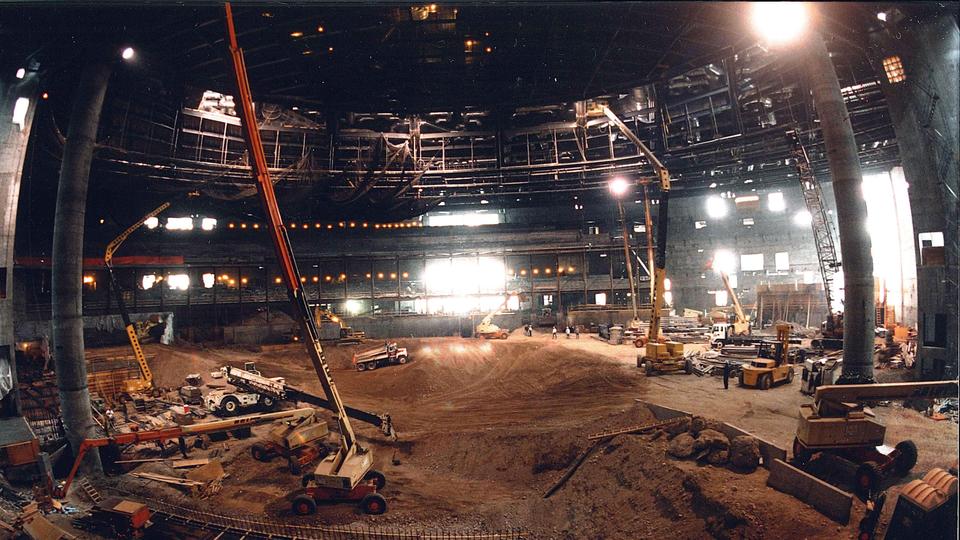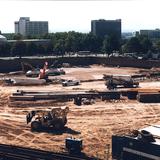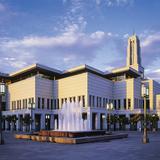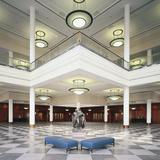Ten years ago this week, members of The Church of Jesus Christ of Latter-day Saints packed the 21,000-seat Conference Center to attend the Church’s first general conference since the completion of the building. Since then, millions of people have visited the Conference Center to attend general conference, take a guided tour or see one of the many cultural events that have been staged inside the 10-year-old building.
“The building of this structure has been a bold undertaking,” said former Church president Gordon B. Hinckley, during the first meeting held in the Conference Center in April of 2000. “We worried about it. We prayed about it. We listened for the whisperings of the Spirit concerning it. And only when we felt the confirming voice of the Lord did we determine to go forward.”
| Foundation preparation, September 1997. 2010 Intellectual Reserve, Inc. All rights reserved. | 1 / 6 |
The construction of the Conference Center started in 1997 — coinciding with the 150th anniversary of the arrival of the early members of the Church into the Salt Lake Valley. The construction of the building symbolized the significant growth of the Church since the coming of early Mormon settlers to Utah.
General conferences were previously held in the historic Tabernacle on Temple Square, but worldwide Church growth necessitated a building that would accommodate more people who desired to attend. Typically, nearly all of the 21,000 seats in the 1.2 million square foot building are filled during each of the five sessions of the conference, which is held in April and October each year. That is about three times as many as the Tabernacle could accommodate.
Significant announcements, such as the Perpetual Education Fund (PEF), new temples and new Church leaders have been made in the Conference Center. Two years ago, President Gordon B. Hinckley’s funeral was held at the Conference Center — offering tens of thousands of people the opportunity to pay their last respects to the prophet.
The Conference Center has also provided a stage to some of the most talented entertainers in the world. While the Conference Center certainly allows more people to attend general conference twice a year, it also serves as a cultural center for the community where artistic presentations, such as dance, theater and musical concerts are held. One of the most popular events of the year held in the Conference Center is the Mormon Tabernacle Choir Christmas concert that has featured performers such as Gladys Knight, Walter Cronkite, Angela Lansbury, Sissel, Natalie Cole, David McCullough and many others. Nearly 85,000 people attend the annual holiday tradition each December.
In 2002 the Winter Olympics came to Salt Lake City, bringing thousands of visitors to the city. The Conference Center played a very important role during the Winter Olympics, offering the perfect space for Light of the World, a cultural show that focused on music and other cultural arts.
Many different theatrical performances, including ones that require impressive stage props, have taken place in the Conference Center. The rostrum can be transformed into a stage to accommodate performances and the ceiling of the auditorium contains more than 1,600 theatrical lights. The Conference Center is also equipped with its own welding and woodworking shops for the purpose of designing and constructing stages.
The Building
One of the most common initial observations visitors make of the Conference Center its size. It is so massive that the Tabernacle on Temple Square could fit within the auditorium’s rostrum area.
Engineers have said that most of what was created inside the Conference Center had been done before in other architectural designs, but never on such a scale. Nearly 1,000 workers from three different major construction companies were on site on a daily basis.
The Zimmer Gunnell Frasca Partnership, based in Portland, Oregon, designed the Conference Center. Architect Bob Frasca said the approach was “to extend the influence of Temple Square.”
The architecturally unique building boasts 1.5 million total square feet, including the four-level parking structure with space for 1,300 vehicles. Contractors used an estimated 116,000 total cubic yards of concrete for the construction of the building. If one cubic yard of concrete was stacked on top of another, there would be a column of concrete 66 miles high. The Conference Center also has 50,000 miles of electrical wiring, enough to circle the earth twice.
A prominent component of the makeup of the building is the giant king truss, which provides the main support for the building. The king truss, which was shipped from Belgium, weighs nearly 620 tons and is 150 feet long, 32 feet high and 4 feet thick. The architects designed the Conference Center in a way that all visitors could have a clear and unobstructed view of the pulpit from anywhere in the auditorium. Since this was the goal, multiple beams could not be used to construct the Conference Center. Instead, the king truss solved the problem and carries the entire weight of the building without obstructing anyone’s view.
Visiting the Conference Center
Since its dedication in 2000, over four million people have toured the Conference Center in tours that are given by part-time Church-service missionaries. There are over 500 of these volunteers who collectively provide over 13,000 service hours every month. Sister missionaries, speaking a myriad of languages, are available to translate for visitors who do not speak English. During their visit, guests are shown the auditorium, the Hall of the Prophets, artwork and the rooftop gardens.
The rooftop is home to nearly four acres of gardens. A large section is planted to look like an open meadow, but there are also landscaped areas, planters and trees. There are also two rooftop water fountains, one of which flows out from under the Conference Center’s spire and cascades down the front of the building into a pool where the water is recycled.







